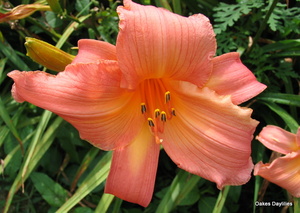Going to the dogs - dogwood that is!
Way back when...the Clinton Power Plant was being built, Illinois Power's forestry personnel were returning the landscape around the lake to a naturalistic environment. They had an area where they planted small starts and would then replant to forest other areas.
This dogwood easily sprouts from twigs, suckers and seed - making it perfect for mass restoration.
When an area had an open house they would send some of those starts to the office as free give aways to our customers. Most starts were bushes or small trees. All the starts were taken except a few tiny Red Osier Dogwood. Rather than throw them away, I took them home and planted.
That was four houses ago. I'd dig up a few shoots each time I moved and they are still gracing my yards.
The Red Osier Dogwood has many great qualities. Obviously, the color of the stems during the winter is a great quality. To have red stems, cut 1/3 of the bush down every few years. The red stems are new growth.
Red Osier Dogwood Cornus sericea, is a native of Illinois. It's other names are Red Willow, Kinnikinnick, Redstem Dogwood, Redtwig Dogwood, Red-rood, American Dogwood, Creek Dogwood, Red Dogwood, Squawbush, California Dogwood, Red-stemmed Cornel, Redbrush, Gutter Tree, Red Willow, harts rouges, Poison Dogwood, Shoemack, Waxberry Cornel, Dog Berry and Western Dogwood. Is it any wonder there's confusion on names in the plant world?
This dogwood, a broadleaf deciduous bush, grows to about 8' x 8'. They are hardy to Zone 3. They like mineral rich soil.
They will have the brightest twigs in full sun and tolerate shade which allows them to be incorporated into a woodland. It's considered semi-fire tolerant. The native prairie fires would cause the seeds to germinate and it would be one of the first plants to grow after fire.
A bush for all seasons, it has white flowers in the spring, berries and red/purple leaves in the fall. The leaves are typically a medium emerald green although there are varieties which have variegated leaves. The bush is not tight and has an informal look. Birds are forever using it for cover, for food, a simple perch or to nest. The berries aren't eaten until late winter when other food is gone.
The Lakota and other plains Native American Indians would use the berries for treating colds and slow bleeding. They would blend the inner bark with tobacco to smoke and this became the Kinnikinnick word for this plant. The twigs are still used for basket weaving.
The roots spread widely and is good for erosion control. For a huge visual impact, plant in mass. For the edge of a woods or as a specimen plant, make sure they are where they can be viewed. They will send up suckers. These suckers can be mowed if they begin to creep into your lawn. They often form huge thickets in wet undisturbed areas.
Provides cover for small critters and is a favorite of deer and moose although I've never had mine destroyed. Bees will be all over the flowers. Trim up the bottom and they will resemble a small tree.
.JPG) Side Note: The Henry County IL Soil & Water Conservation District 2012 Spring Tree Sale is being held until March 19th. Call 309-937-5263, Ext. 3, for a brochure. They offer two kinds of red twig dogwood.
Side Note: The Henry County IL Soil & Water Conservation District 2012 Spring Tree Sale is being held until March 19th. Call 309-937-5263, Ext. 3, for a brochure. They offer two kinds of red twig dogwood. .JPG)

.JPG)
.JPG)
.JPG)

.JPG)



.JPG)
.JPG)

.JPG)



.JPG)
.JPG)
.JPG)
.JPG)
.JPG)
.JPG)
.JPG)
.JPG)

+Jeffersonia+diphyllia.jpg)

















.JPG)
.JPG)






